This recipe for homemade pasta noodles uses only 3 ingredients! Read on to learn my secrets for perfect extruded pasta noodles every time.
Over the Christmas holiday, my family gifted me with a Kitchenaid Pasta Press attachment — the one that makes cute little noodle shapes like fusilli, rigatoni, and elbow macaroni. This is not the pasta machine that makes spaghetti and fettuccini noodles. There are two different pasta attachments for the KitchenAid mixer.
Many people have been as frustrated as I have because the recipe in the booklet doesn't always give you the best results for making the noodles.
Finding the right dough recipe for making homemade pasta noodles can be difficult, but I have you covered.
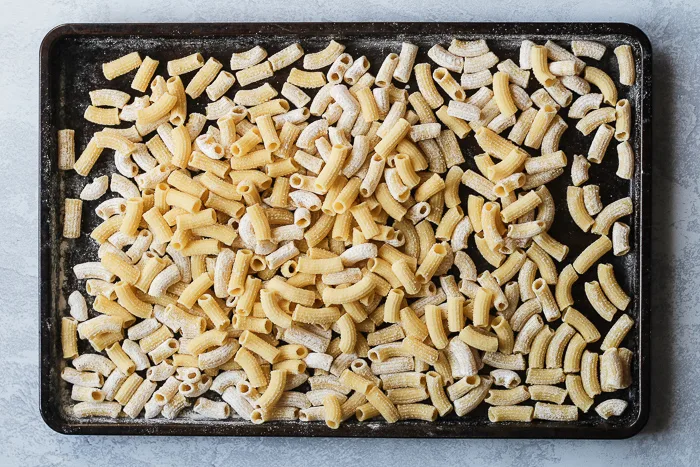
I have finally found the perfect recipe so today I am going to share my tips and tricks with you!
A Foolproof Recipe for Making Homemade Pasta Noodles
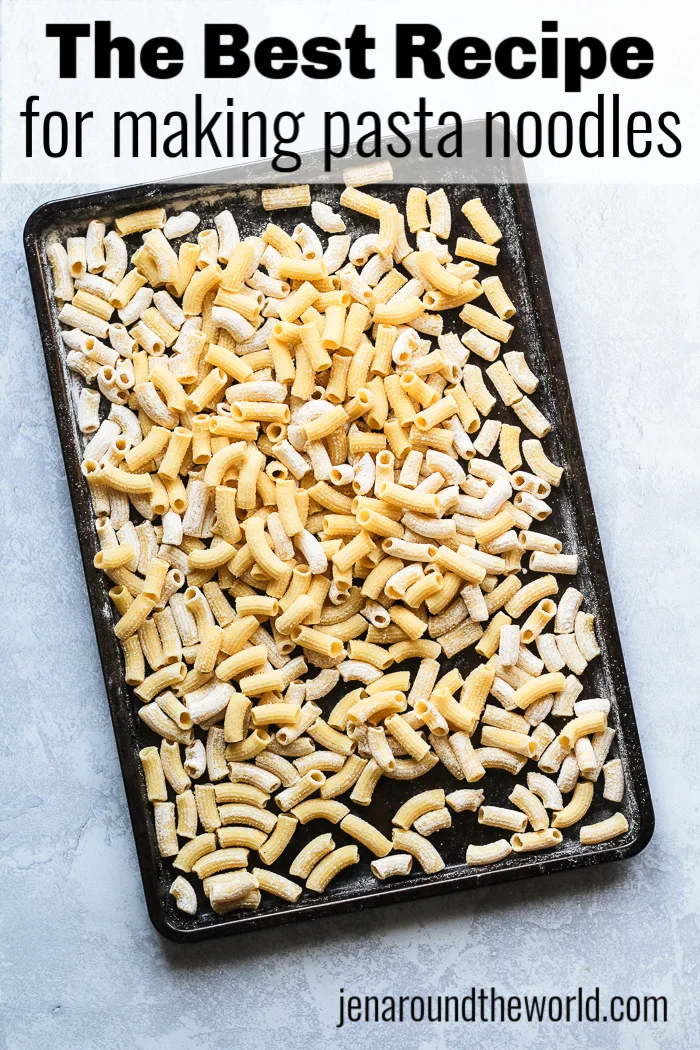
Using my pasta press for the first time was exciting. The recipe in the book was disappointing at best. So, I kept going until I found one that worked.
The dough in the original recipe sticks to the inside and won't come out of the press.
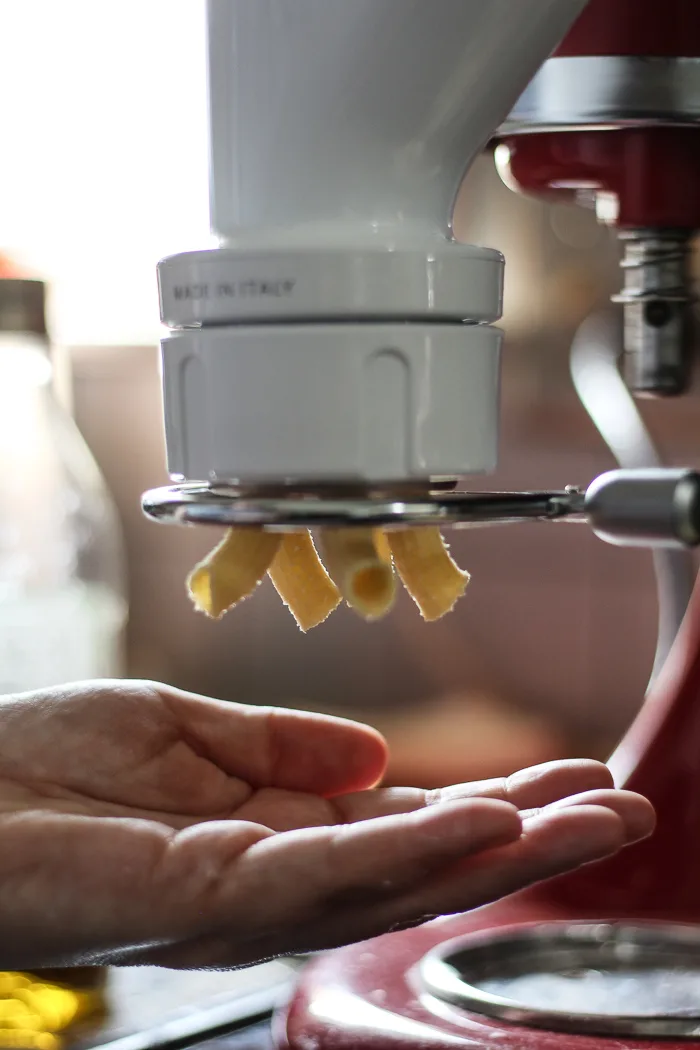
Then I tried another dough, and it wound up being too dry. I had no clue what I was going to do. I was at the point where I was ready to pack up my pasta press and send it back to Amazon where it came from.
Then I came upon another recipe that said you could add extra eggs and olive oil to the dough and it would make all the difference in the world. And you know what? It did! So basically, add the flour to your work surface, make a well in the center, and add the eggs to the center of the flour. Mix a little at a time until the dough comes together and now you are ready to add it to the pasta press.
Last night we successfully made over a pound of pasta dough with this easy recipe that uses simple ingredients. You can use this pasta in my Southern Cream Cheese noodles recipe. This dough is much different from the sheet of pasta I use for my homemade lasagna noodles.
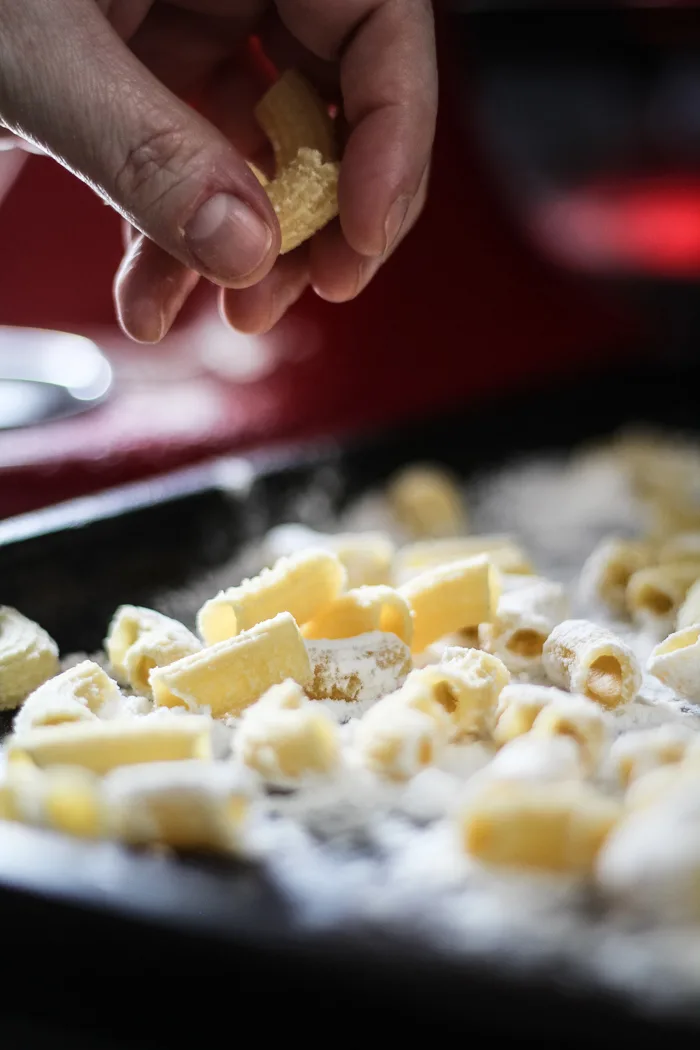
Let me take a moment to explain what extruded pasta is and how it’s different from other pasta. Extruded pasta is made by forcing dry flour and egg dough through a die.
Spaghetti, rotini, fusilli, penne, bucatini, macaroni, and rigatoni are all examples of extruded store-bought pasta. Freshly extruded pasta is rare, but most of the dried pasta sold at the grocery store is extruded.
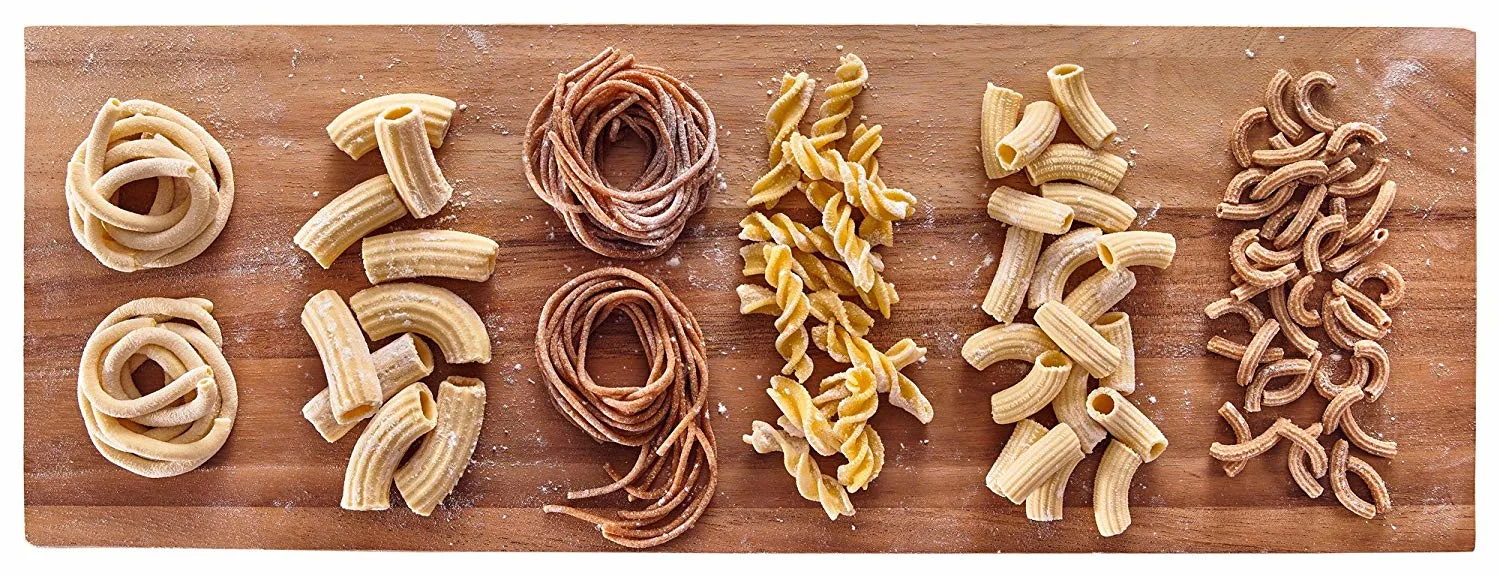
Rolled pasta, like spaghetti and fettucini, on the other hand, is made by rolling out a flour-and-egg dough using your pasta roller attachment set on the widest setting and dough hook. Then roll the pasta sheet up and cut it into strips with a pizza cutter or bench scraper to the desired width.
Examples of rolled cut pasta include lasagna, linguini, fettuccini, tagliatelle, and pappardelle. When pasta is made at home, it’s usually the rolled type of pasta.
Also, another thing to keep in mind: it can go bad and there are a few ways to notice it's off.
How to Make the Best Fresh Pasta Dough for Extruding Pasta
So — are you wondering what my recipe is? Here's the secret —
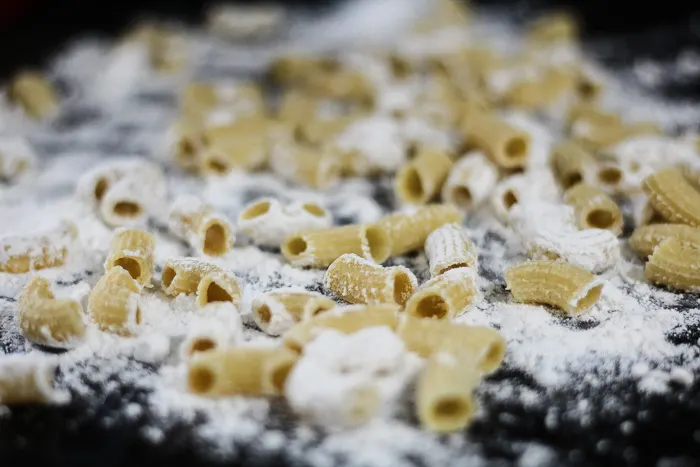
You need to use 3 1/2 cups of all-purpose flour and 5 large eggs to get your dough going. I used whole eggs for this recipe instead of pasta made with just egg yolk. Don't skip this. The whole egg is important.
Instead of using water to make it come together, use olive oil! I use all-purpose for this recipe so do not use semolina flour, which is what most people use for pasta recipes.
The olive oil will help the dough stay dry enough to come together and will keep the dough from sticking to the inside of the attachment. This means your noodles will come out perfect and easily every single time.
Now – the amount of olive oil that you use will determine the area where you live. Start with two tablespoons and move on from there. It took me about 3 tablespoons of oil and 1 tablespoon of water to make my dough come together.
It turned out beautiful and cooked up even better!
To get the dough ball pliable like you want, use a rolling pin to roll it out on a clean surface and then mold it back up. Cover it in plastic wrap and let the dough rest at room temperature on the counter for a bit.
When you are ready to make the pasta, attach the pasta maker to the KitchenAid Mixer. Fresh homemade pasta is the best.
Start by creating a clean work-floured surface. I use a baking sheet that I sprinkle flour on for the pasta to rest on.
Cut off sections of the dough ball and feed it into the extruder. As the pasta comes out, it should fall perfectly onto the baking tray. Cover the rest of the dough with plastic wrap until ready to use.
You will also need a sharp knife just in case you need to cut the pasta, but the machine should do all the work.
Cook the pasta for about 2 to 3 minutes until al dente and then serve it with your favorite sauce. My favorite is my homemade spaghetti sauce with fresh tomatoes.
How to Store Homemade Pasta Dough
You can let the homemade noodles air dry and then store it in packages, or you can freeze the fresh pasta in an airtight container and pull it out when you are ready to use it. I like doing it this way because it takes less time to cook it. Once you dry the pasta out, it takes a lot longer to cook it.

Check Out These Other KitchenAid recipes
- How to make homemade butter
- Cinnamon Swirl Bread
- Homemade Cream Cheese Frosting
- Southern Cream Cheese Noodles
The Best Recipe for Making Homemade Pasta Noodles (plus a look at the Kitchenaid Pasta Press Attachment)
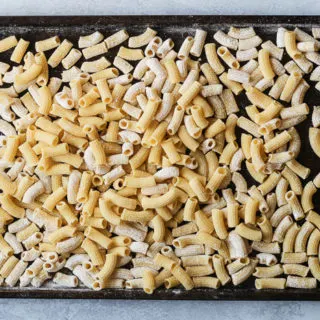
This recipe is a base for making easy homemade extruded pasta noodles from scratch
Ingredients
- 3 1/2 cups of all-purpose flour
- 5 large eggs
- 2 tbsp olive oil (may need more depending on the dryness of your dough)
Instructions
- In your Kitchenaid mixer, combine the flour and 5 large eggs and mix. Add in olive oil to make the dough come together just a bit. The dough should be very dry—so dry that it won’t even come together into a single mass.
- Pour the dough out onto the work surface and pinch off walnut-size pieces to feed into the extruder.
- Don't shove it down in there as that will cause a big clog and mess everything up. Larger amounts of dough tend to bind up in the extruder as they reach the auger.
- Using the cutter on your attachment, as the pasta comes out, cut it off and lay it in a single layer on a floured surface to dry.
- Cook the homemade extruded pasta as you would any other pasta, in a large pot of boiling, salted water until al dente. Cooking time will vary depending on how wet the dough was and how long the pasta was dried. Mine took about 4 minutes.
- Finally, disassemble the extruder, remove any large gobs of dough, and let the rest dry overnight before attempting to clean the parts. The dough will flick right off once it’s completely dry.
- Remove using a slotted spoon and add to your sauce
- Toss to coat the pasta and serve
Recommended Products
As an Amazon Associate and member of other affiliate programs, I earn from qualifying purchases.
Nutrition Information:
Yield:
10Serving Size:
2 ouncesAmount Per Serving: Calories: 219Total Fat: 6gSaturated Fat: 1gTrans Fat: 0gUnsaturated Fat: 4gCholesterol: 93mgSodium: 36mgCarbohydrates: 34gFiber: 1gSugar: 0gProtein: 8g
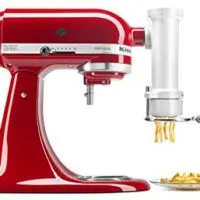
Megan
Saturday 28th of September 2024
Oh, thank you! My hubby got me a pasta press for my birthday, and when I saw how dry the dough was using their recipe, I switched to mine, which turned out to be too wet and did exactly what you said it would. It was a B-and-half to clean out my press. The pasta still tasted good with mine, but it was just so sticky and thick. Yours is the first recipe I've found that warns of the issues I had and how to address them.
Thank you so much for that. I've come across too many recipes that promise a perfect outcome but end up nothing like they were supposed to, making me think steps were left out or the cook is assuming the people making their recipe have a certain level of knowledge.
Jennifer Sikora
Sunday 29th of September 2024
I am so glad it worked for you. SO many have had issues. I am just glad we all have the perfect recipe now so we can use our presses without wanting to throw it out!
Jas
Monday 1st of April 2024
Just made this and it made 2 pounds for me. Cooked 1 pound and froze the other but vacuum sealed it not thinking😅 has anyone done this and the noodles be fine?
Jennifer Sikora
Tuesday 2nd of April 2024
You need to let them air dry before freezing but maybe they will be ok?? All I can tell you is to give it a try and see what happens.
Kyle Barber
Wednesday 3rd of January 2024
Worst recipe ever Look for the kitchen aid one that comes in the book
Jennifer Sikora
Thursday 4th of January 2024
If you had read the post instead of just commenting something hateful, you would have seen that i did indeed tried to use that recipe and it was horrible. Sorry if you had a bad experience but everyone has said this recipe is perfect for them.
Tara
Sunday 26th of November 2023
I made this tonight and found my noodles came out super dough like. I used the rigatoni attachment. Any ideas as to what I did wrong? They were just super dense and almost dumpling like.
Thanks!
Jennifer Sikora
Monday 27th of November 2023
I am not sure. Usually that means not enough flour I think??
Kara
Monday 14th of August 2023
I love this recipe! Thank you so much for sharing it. I used your example of 3 T olive oil and 1T water. The proportions were on point with no additions needed. The dough extruded beautifully. I used my go to noodle flour mix of half semolina and half 00. I used my food processor to pulse the dough together as I have found it is easier on my mixer so the motor is cool for attachments. I cranked the speed to high and *bam* perfect noodles!
I'll be making this again and again. I already made it twice this morning. Would make more but I ran out of eggs. Lol
Jennifer Sikora
Thursday 17th of August 2023
I love hearing that! This has been a perfect recipe for a lot of people :)